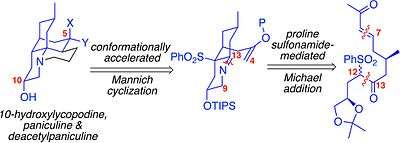10-Hydroxy Lycopodium alkaloids
The 10-hydroxy Lycopodium alkaloids, 10-hydroxylycopodine, deacetylpaniculine and paniculine, are a series of natural products isolated from a Chilean club moss Lycopodium confertum. Deacetylpaniculine and paniculine were also isolated from Lycopodium paniculatum.[1]
The Lycopodium alkaloids are of interest due to their biological activity and unique skeletal characteristics,[2] however, many compounds in this class have not been well studied.
Synthesis

The first enantioselective synthesis of 10-hydroxylycopodine, deacetylpaniculine and paniculine was published by Mrinmoy Saha and Rich Carter in 2013. Two key ring-closure steps were accomplished by an organocatalytic Michael reaction and a Lewis acid-catalyzed Mannich reaction.[3] The impact of the C10 stereochemistry on the Michael addition to construct the C7–C12 bond and on the Mannich cyclization have been explored recently. [4]
See also
References
- ↑ Muñoz, Orlando M.; Castillo, M.; San Feliciano, A. (January 1990). "High Resolution NMR Studies of Paniculine and Related Lycopodium Compounds". Journal of Natural Products. 53 (1): 200–203. doi:10.1021/np50067a032.
- ↑ "Lycopodine and the Lycopodium Alkaloids" (PDF).
- ↑ Saha, Mrinmoy; Carter, Rich G. (February 2013). "Toward a Unified Approach for the Lycopodines: Synthesis of 10-Hydroxylycopodine, Deacetylpaniculine, and Paniculine". Organic Letters. 15 (4): 736–739. doi:10.1021/ol303272w. PMC 3616490
 . PMID 23384410.
. PMID 23384410. - ↑ Saha, Mrinmoy; Li, Xin; Collett, Nathan D.; Carter, Rich G. (June 2016). "Unified Synthesis of 10-Oxygenated Lycopodium Alkaloids: Impact of C10-Stereochemistry on Reactivity". Organic Letters. 81 (14): 5963−5980. doi:10.1021/acs.joc.6b00900.